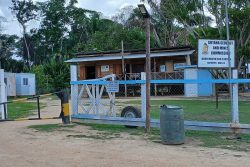Johil Green Farms’ proposed soybean farm in the Rupununi would see a capital outlay of $664 million in the first year.
The project would span 5,000 acres in the vicinity of the Lamparina Lake in the North Rupununi Savannah, and recently submitted an application to the Environmental Protection Agency (EPA) for environmental authorization.
According to the project summary, the farm will require freshwater from the nearby Takutu River and Lamparina Lake as well as creeks. During the prolonged dry season irrigation methods will need to be developed including the construction of a network of canals to facilitate both irrigation and land drainage.
The company will be required to seek the various permissions from the National Drainage and Irrigation Authority prior to any construction of canals. The project summary contended that the developer “intends to comply with all regulations and guidelines prescribed by the Environmental Protection Agency (EPA)…to ensure good environmental and agricultural practices are maintained throughout the various phases of this operation.”
The EPA said the development may have significant impacts on the environment and in a recent advertisement invited the public to write to the agency within 28 days, with any questions and concerns so that these can be addressed in the Environmental Impact Assessment. The project summary stated that by practicing organic soybean cultivation the company will make provisions for the mitigation of genetic erosion.
Agriculture Minister Dr Leslie Ramsammy told Stabroek News that Guyana is aiming to produce 10,000 tonnes of soybean by 2020.
Johil Green Farms’ project summary does not say if the investments will be foreign or local, nor does it state the complete cost, inclusive of the start-up requirements.
Johil’s developers are Guyanese of Brazilian heritage “with strong connection,” the project summary said and its owner was identified as Jeanne Disarz.
It noted that Guyana imports all of its soya needs and the project would therefore meet this demand.
During the first phase of the project, the summary said, it is expected that 30 persons would be employed in the farm’s operations. During the land preparation, construction and farm start up, the summary said, the number of persons to be employed would be closer to 50. Key management positions are to be filled initially by persons not residing in Region Nine.
As part of its mitigation, Johil plans to establish perennial vegetative cover to protect soil and water resources.
At least one company, Santa Fe is conducting large scale farming in the area. Santa Fe is cultivating rice on a large scale and the paddy is exported to Brazil for milling.
Other companies are exploring setting up large-scale farms here. In December, 15 potential large-scale agriculture investors from Trinidad and Tobago scouted possible sites in the Canje Basin as part of a year-old Memorandum of Understanding (MOU) with Guyana.
The MOU had named corn, soya, cassava, legumes, small ruminants and aquaculture as the areas of interest and both Trinidad and Guyana’s Agriculture Ministers highlighted corn and soya as the likely frontrunners.
Agriculture Minister Dr Leslie Ramsammy had told Stabroek News that this was a long-term plan, hence liquidity was essential as large-scale farming was not an overnight operation. Ramsammy stated that the investors were responsible for conducting scoping exercises.
He said the land available in the Canje Basin and Intermediate Savannahs was suitable to grow certain crops and investors would need to be aware of these things.
The MOU is currently in limbo, with no confirmed investors and no firmup projects. Neither Ramsammy nor his T&T counterpart touched on areas other than the Canje Basin that may have been visited. Last year, teams from T&T had visited several areas, including Mahaica-Berbice. While additional technical teams were here for the two-day period, no findings were released from the technical visits.








